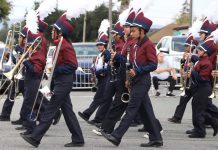
Dressed in orange vests, they’re armed only with a red octagon
and a guardian angel.
These brave souls literally risk their lives every day to ensure
the safety of the county’s school children without much help from
the public.
Crossing guards put their bodies between students and speeding
cars
– and sometimes, drivers who dare drive right through an
inhabited crosswalk.
Dressed in orange vests, they’re armed only with a red octagon and a guardian angel.
These brave souls literally risk their lives every day to ensure the safety of the county’s school children without much help from the public.
Crossing guards put their bodies between students and speeding cars – and sometimes, drivers who dare drive right through an inhabited crosswalk.
“They’ll come through the crosswalk even with them (crossing guards) there,” said Bob Hammond, principal of Ladd Lane School who also serves as a crossing guard. “People don’t pay attention to kids crossing the streets. It’s just a matter of people slowing down around schools.”
For crossing guards, the situation has gotten worse during the years. With increased population comes more traffic and less safety.
Also, since so many residents commute or are from San Jose, they are used to driving San Jose speeds.
“It’s busier – both cars and pedestrians. They’ve both gotten worse,” said Laura Russell, a campus supervisor at San Benito High School going on 14 years. “It’s not getting better, it’s getting worse.”
Not only has the county grown, but SBHS’ population is more than 2,800 students, Russell said.
Speeding presents the biggest danger for crossing guards. People speed around schools for various reasons, but crossing guards remind drivers that the speed limit is 25 miles per hour around schools.
In the morning and afternoon, drivers seem to be in a rush, said Sofie Acosta, a campus supervisor at Rancho San Justo Middle School.
“Yes, I understand they’re late, but they need to slow down,” Acosta said remembering one incident when she felt the heat of a car’s engine right behind her as it drove through a crosswalk she was in.
Although it’s rare, students and crossing guards have been hit in crosswalks, usually because a car went through even though a crossing guard was crossing students.
Crossing guards have to be able to pay attention to a lot of things at once, said Mercedes Berglund, supervisor of security at SBHS. She advises supervisors to be cognizant and use their voice.
“You need to be aware of your surroundings. I tell them to listen to the sound of the tires – that will tell you how fast the car is going and whether it will stop,” Berglund said. “You need to really be on your toes. I tell them ‘You have a voice – use that voice out there.'”
Russell said she makes eye contact with drivers to make sure they are stopping. Starting out into the street doesn’t work because students on the other side of the street start crossing before Russell has made sure it’s safe, she said.
These concerns are the main reason staff at SBHS want to shut down Nash Road around the school, if only temporarily from around 7:30 to 8:30 a.m. and 2:15 to 3:15 p.m. – the school’s peak times, Berglund said.
Crossing guards new to the job have a hard time telling how safe it is to cross the street. In her second year at SBHS, campus supervisor Maria Arroyo said she was nervous when she starting working at Nash Road and Monterey Street.
“Around the third time, I felt more confident, more alert,” Arroyo said.
Despite the nervousness, some flourish on the fear and challenge of getting kids to and from school safely. Acosta enjoys it and rarely feels in danger.
“I thrive on this job. I love being with kids,” she said. “The kids know I’d do anything for them.”
Campus supervisors offer suggestions for decreasing driver frustration and increasing student safety. They say people need to keep their frustration in check – not getting into a hurry or speeding around schools and traffic. Even though there have been few accidents in the past, it can still happen at any minute to anyone.
Also, it’s best to avoid schools around 8 a.m. and 3 p.m. Although an alternative route may be longer, it could take less time because of less traffic. To the crossing guards, it’s a simple equation: Less traffic equals more safety.
“We are out there trying to get your child home safely,” Berglund said. “We’re just trying to protect students from being injured.”









